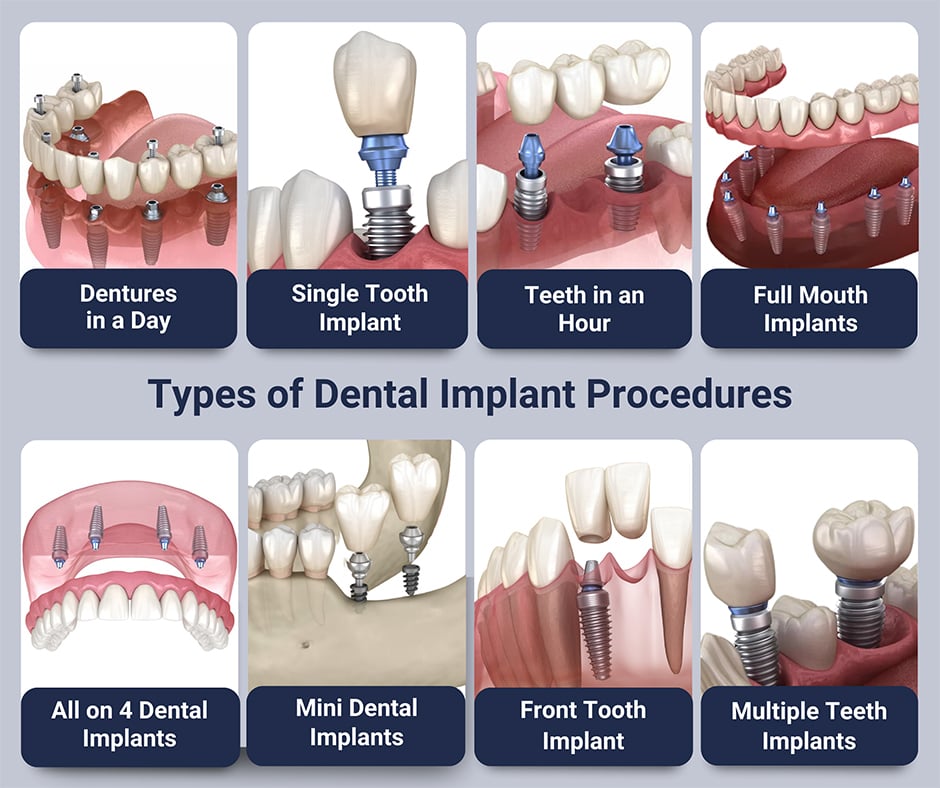Everything about Dental Implants
Table of ContentsThe Definitive Guide to Dental ImplantsDental Implants for Beginners6 Simple Techniques For Dental ImplantsWhat Does Dental Implants Do?
are medical devices operatively implanted into the jaw to bring back an individual's ability to chew or their look. They provide support for man-made (fake) teeth, such as crowns, bridges, or dentures. When a tooth is lost because of injury or disease, a person can experience problems such as rapid bone loss, faulty speech, or changes to chewing patterns that result in pain.
Framework of The Oral Implant System selecting oral implants, talk to your dental supplier regarding the possible advantages and threats, and whether you are a candidate for the procedure. Things to take into consideration: Your total wellness is an essential variable in establishing whether you are a good prospect for dental implants, the length of time it will require to recover, and exactly how long the implant might remain in place.
Smoking might affect the healing procedure and reduce the long-lasting success of the dental implant. The recovery process for the implant body might take a number of months or longer, during which time you commonly have a temporary abutment in location of the tooth. the dental implant procedure: Thoroughly follow the dental health instructions given to you by your oral copyright.
How Dental Implants can Save You Time, Stress, and Money.
Implant failing can lead to the demand for one more operation to fix or replace the implant system. Recovers the capacity to chew Recovers aesthetic look Helps maintain the jawbone from reducing as a result of bone loss Maintains the health of the surrounding bone and gum tissues Assists maintain surrounding (nearby) teeth steady Enhances lifestyle Damage to surrounding natural teeth throughout implant positioning Injury to the surrounding tissues during surgical treatment, such as sinus opening Injury throughout surgery (as an example, crack of bordering jawbone) Insufficient feature, such as really feeling like the teeth do not attack with each other usually A sensation that the tooth is loose or twisting in position arising from a joint screw loosening Implant body failing (looseness of the dental implant body) as a result of systemic infection, which might be a lot more most likely in people with unchecked diabetes because of regional infection in bone and periodontals sustaining the implant body as a websites result of postponed healing, which might be more probable in individuals who smoke Problem cleaning up the gums around the implant, causing poor oral health Unattended periodontal illness Post-surgical numbness due to nerve impingement or damages Constantly inform healthcare service providers and imaging technicians that you have dental implants before any kind of magnetic resonance imaging (MRI) or x-ray procedures.
FDA is not familiar with any type of negative events reported for MRI or x-ray procedures with oral implants. Oral implants systems are normally constructed from materials that follow international consensus criteria of the International Organization for Standardization (ISO) or ASTM International. These standards have information of what makes a secure product.
Various other products such as gold alloys, cobalt-based alloys, titanium alloys, or ceramic materials are occasionally made use of. The security profiles of these materials are popular. Dental dental implant systems are reviewed according to worldwide agreement requirements. Biocompatibility screening, to reveal that physical contact with the tool does not trigger difficulties like irritation or allergic response, becomes part of the analysis that helps make sure the materials in the dental implant system are safe and do not cause unfavorable results when dental implanted in individuals.

Things about Dental Implants
Some individuals are not eligible for dental implant surgery. It is for dental doctors to operate on individuals with: intense illnessuncontrollable metabolic diseasebone or soft tissue condition or infectionIf these concerns are resolved, a person can have the surgery. Dental Implants. In, oral doctors avoid running on individuals with: If people with any one of the above undergo dental implant surgical procedure, there is a higher risk of the implant failing
Some individuals have a jawbone abnormality that avoids enough bone for a dental implant from establishing. In such cases, a cosmetic surgeon might require to do a ridge adjustment. This involves lifting the gum tissue to expose the area of deformed bone. The cosmetic surgeon will after that utilize a bone or bone alternative to fix and develop up the area.
Dental dental implant surgical treatment is a tailored process. It's not the same for everybody. The following gives a basic overview of what you can anticipate your dental expert, oral specialist, periodontist or prosthodontist to do: Position the implant surgically. Give you time to recover. Connect the message and last crown, bridge or denture.
Next, your specialist look at these guys will thoroughly position the oral implant right into your jaw. Your cosmetic surgeon will reposition your periodontals and shut the incision with stitches (Dental Implants). more info here If your implant is near the front of your mouth, your dentist will certainly make a momentary tooth for you to put on until you recover. This way, you won't have a space in your smile while you recoup.
A Biased View of Dental Implants
Your copyright can tell you what to anticipate in your circumstance. During the healing stage, your jawbone must fuse to the dental implant. This process, called osseointegration, is vital for security and lasting success. This procedure can take anywhere from 3 to nine months. In some situations, it might take longer.
When your implant heals, your dental practitioner can affix the joint (little adapter blog post) and your last remediation (crown, bridge or denture). This normally takes about one hour to finish and may call for a second small surgery. You shouldn't feel any kind of discomfort throughout your dental implant procedure because your copyright will certainly use medication to numb your periodontals.